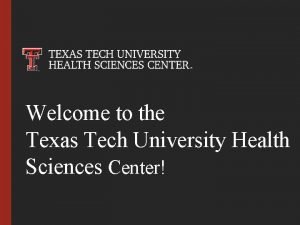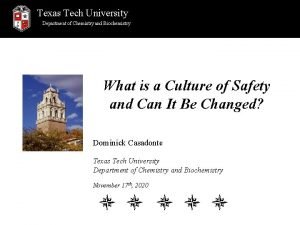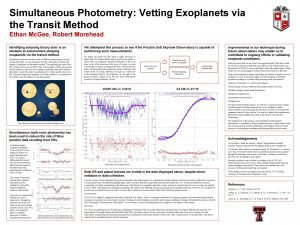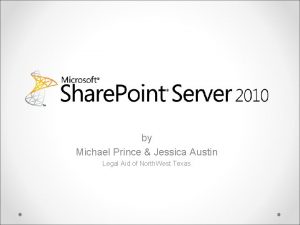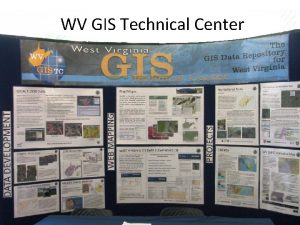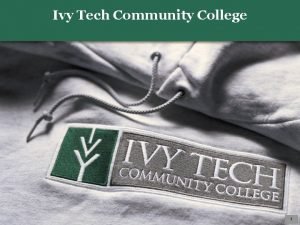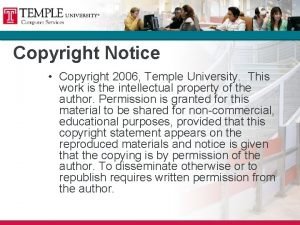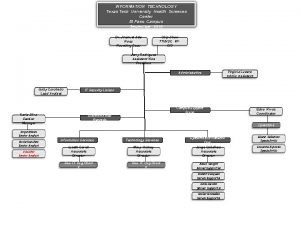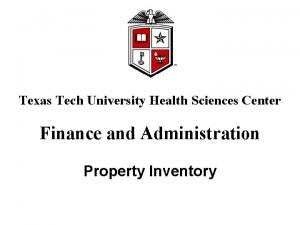3 0 Texas Power Tech University Center for













- Slides: 13

3. 0 Texas. Power Tech University Center for Pulsed and Power Electronics Center for Pulsed Power and Power Electronics Texas Tech University - Lubbock, TX 2018 IEEE IPMHV Conference, Jackson Hole, WY June 5, 2018 1 Modeling Power Factor Correction Circuits with LTspice Michael G Giesselmann and Vishwajit Roy Texas Tech University Center for Pulsed Power and Power Electronics 2018 IEEE IPMHV Conference, Oral Session 3. 0 IEEE International Power Modulator and High Voltage Conference June 3 rd-7 th, 2018

Center for Pulsed Power and Power Electronics Texas Tech University - Lubbock, TX Abstract LTspice is a powerful simulation language that is specifically optimized for modeling Switch Mode Power conversion. It is not limited to small numbers of nodes and freely available [1]. We are presenting several examples of simulations for popular electronic power factor correction circuits that improve the input power factor of AC Power Supplies by active waveshaping of the AC input current and the associated avoidance of harmonics. The simulations are performed using a cycle-by cycle switching approach as well as using a time averaged PWM model. A fast inner current loop is controlling the shape of the input current such that it matches the sinusoidal shape of the AC input voltage. A time averaged PWM model is useful for fast simulations covering many cycles to design and study secondary feedback control that regulates the output voltage of the converter. 2 Keywords—Boost converter; Power Factor Correction; Time Averaged models; Feedback control; LTspice

Center for Pulsed Power and Power Electronics Texas Tech University - Lubbock, TX AC rectifier without Power Factor Correction 3

Center for Pulsed Power and Power Electronics Texas Tech University - Lubbock, TX Waveforms & Spectrum of AC rectifier with no PF Correction 4 DC-Bus Voltage AC-Input Current Harmonics

Center for Pulsed Power and Power Electronics Texas Tech University - Lubbock, TX AC-Rectifier with Boost Converter for Power Factor Correction 5

Center for Pulsed Power and Power Electronics Texas Tech University - Lubbock, TX Pre-Charge & PWM Controller Sub-circuits 6

Center for Pulsed Power and Power Electronics Texas Tech University - Lubbock, TX Waveforms of AC rectifier with PF Correction 7 DC-Bus Voltage AC-Input Current

Center for Pulsed Power and Power Electronics Texas Tech University - Lubbock, TX Spectrum of AC rectifier with PF Correction 8

Center for Pulsed Power and Power Electronics Texas Tech University - Lubbock, TX 9 Switch-Mode & Time Averaged Models

Center for Pulsed Power and Power Electronics Texas Tech University - Lubbock, TX Time Averaged PWM Sub-circuit 10

Center for Pulsed Power and Power Electronics Texas Tech University - Lubbock, TX Waveforms of AC rectifier with PF Correction 11 Duty Cycle DC-Bus Voltage AC-Input Current

Center for Pulsed Power and Power Electronics Texas Tech University - Lubbock, TX Conclusions In this paper we have shown simulations of Boost converters used to draw a nearly sinusoidal input current from a AC source and thus avoiding harmonics. This will result in a power factor which is close to unity. We compared a conventional model that uses a cycle-bycycle switching approach with a model using a time-averaged switch. We found that the results of both models agree very closely. Since there are no high frequency switching transitions that need to be followed, the model with the time-averaged switch can run orders of magnitude faster in a stand-alone simulation. This model can also be used in a frequency domain simulation with the duty cycle input being an analog control variable. The basic model of the time averaged switch shown in Fig. 10 is further expanded by Ned Mohan as a basic pole of a power electronics converter suitable for a wide variety of applications. 12

Center for Pulsed Power and Power Electronics Texas Tech University - Lubbock, TX References 1. LTspice, Analog Devices, One Technology Way, P. O. Box 9106 2. Norwood, MA 02062 -9106, http: //www. analog. com/en/design-center/designtools-and-calculators/ltspice-simulator. html 3. IEEE Standard 519, IEEE Recommended Practice and Requirements for Harmonic Control in Electric Power Systems, 2014 edition, https: //ieeexplore. ieee. org/document/6826459/ 4. Ned Mohan, Tore M. Undeland, William P. Robbins, Power Electronics, Converters, Applications, and Design, © 1989, John Wiley & Sons, Inc. 5. Josef L. Smolenski, Gerard W. Christopher, John C. Wright, and Alfred E. Relation, “AC to DC Power Conversion circuit with low Harmonic Distortion”, US Patent 5, 019, 952, May 28, 1991. 6. Muhammad H. Rashid, “Power Electronics Handbook”, Chapter 41, “Computer Simulation of Power Electronics and Motor Drives” by M. Giesselmann, P. 1124, Academic Press, ISBN 13: 978 -0 -12 -088479 -7. 7. M. G. Giesselmann, “Averaged and cycle by cycle switching models for buck, boost, buck-boost and cuk converters with common average switch model”, Proceedings of the 32 nd Intersociety Energy Conversion Engineering Conference, IECEC-97, Honolulu, Hawaii, DOI: 10. 1109/IECEC. 1997. 659210. 8. Ned Mohan, “Electric Drives, An interactive Approach”, MNPERE, Minneapolis, 2003 edition, chapter 4. 13
 Student business services ttu
Student business services ttu No tech assistive technology
No tech assistive technology Power traiangle
Power traiangle Texas tech webraider
Texas tech webraider Texas tech departments
Texas tech departments Texas tech observatory
Texas tech observatory Michael prince texas tech
Michael prince texas tech Ttu spanish placement exam
Ttu spanish placement exam Texas tech application process
Texas tech application process Techbuy ttu
Techbuy ttu Texas tech eraider employee
Texas tech eraider employee Wv gis tech center
Wv gis tech center Ivy tech zoom advising
Ivy tech zoom advising Temple tech center breakout rooms
Temple tech center breakout rooms



